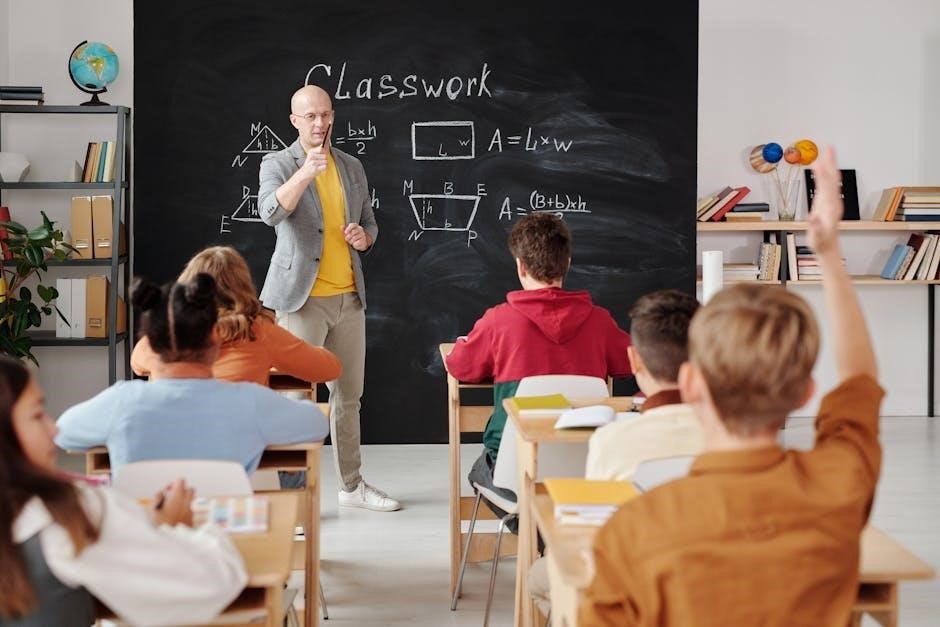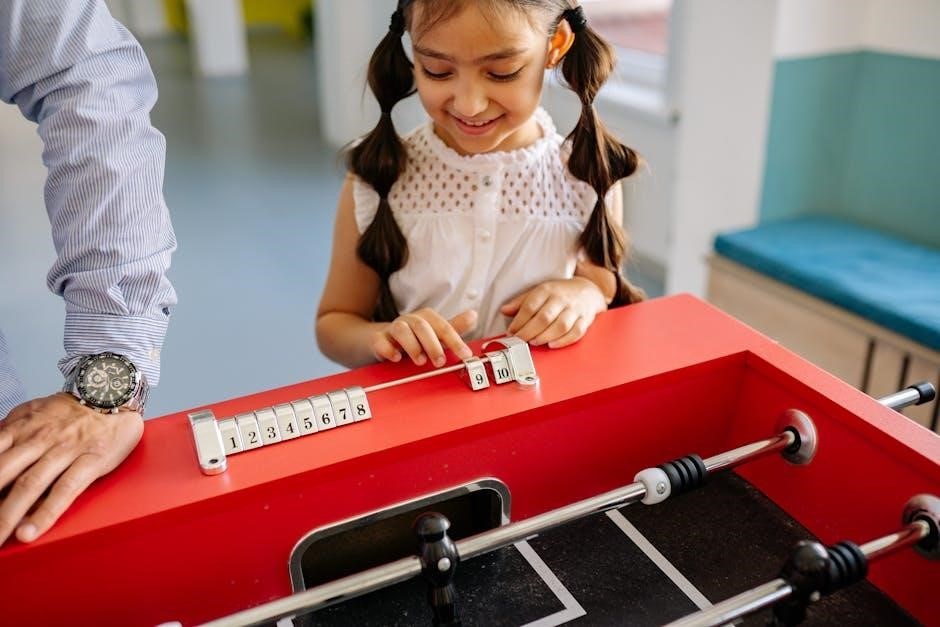The manual teacher plays a crucial role in guiding students through lessons‚ using a comprehensive teaching manual as a resource to support effective instruction and promote learning outcomes successfully always.
Definition and Role
The manual teacher is defined as an educator who uses a teaching manual to guide students through lessons‚ providing a structured approach to learning. The role of the manual teacher is to support students in developing their skills and knowledge‚ using the manual as a resource to promote effective instruction and learning outcomes. The teacher’s role is multifaceted‚ involving the delivery of lessons‚ assessment of student progress‚ and provision of feedback to students. The manual serves as a tool to help the teacher achieve these goals‚ providing a comprehensive guide to teaching and learning. By using the manual‚ the teacher can ensure that students receive a consistent and high-quality education‚ with clear learning objectives and outcomes. The manual teacher’s role is critical in promoting student success and achieving educational goals‚ and the manual is an essential resource in supporting this process‚ with its detailed lesson plans and activities.
Importance of Teaching Manual
The teaching manual is a vital component of the educational process‚ providing a structured approach to teaching and learning. It serves as a guide for teachers‚ outlining the key concepts and skills to be covered in each lesson. The manual is essential in ensuring that students receive a consistent and high-quality education‚ with clear learning objectives and outcomes. By using a teaching manual‚ teachers can plan and deliver lessons more effectively‚ assessing student progress and providing feedback to support learning. The manual also helps to promote student engagement and motivation‚ with its detailed lesson plans and activities. Overall‚ the teaching manual plays a critical role in supporting the educational process‚ providing a comprehensive resource for teachers to support student learning and achievement‚ and helping to ensure that students reach their full potential‚ with a well-structured and effective approach to teaching and learning‚ every day.

Components of Reading
Reading components include phonological awareness‚ phonics‚ and fluency‚ with a comprehensive approach to teaching reading skills effectively always in the classroom setting every day with teachers.
Phonological Awareness
Phonological awareness is a crucial component of reading‚ involving the ability to identify and manipulate sounds in spoken language‚ with a focus on phonemic awareness and rhyming skills;
The manual teacher uses a variety of activities to teach phonological awareness‚ including word families‚ segmenting‚ and blending sounds.
This component is essential for developing reading skills‚ as it helps students to decode words and comprehend text.
The teacher’s manual provides a comprehensive approach to teaching phonological awareness‚ with step-by-step lessons and activities to support student learning.
By incorporating phonological awareness into the reading curriculum‚ teachers can help students to develop a strong foundation in reading and improve their overall literacy skills.
The Internet provides a wealth of resources and information on teaching phonological awareness‚ including lesson plans‚ activities‚ and assessments to support teacher instruction and student learning effectively always.
Phonics and Decoding
Phonics and decoding are essential skills for reading‚ involving the relationship between sounds and letters‚ with a focus on alphabetical knowledge and sound-symbol association.
The manual teacher uses a systematic approach to teach phonics and decoding‚ with an emphasis on explicit instruction and practice.
This component is critical for developing reading fluency and comprehension‚ as it enables students to recognize and decode words accurately.
The teacher’s manual provides a comprehensive guide to teaching phonics and decoding‚ with lessons and activities tailored to meet the needs of diverse learners.
By incorporating phonics and decoding into the reading curriculum‚ teachers can help students to develop a strong foundation in reading and improve their overall literacy skills.
The Internet offers a range of resources and support for teaching phonics and decoding‚ including instructional materials‚ assessments‚ and professional development opportunities to enhance teacher effectiveness and student achievement always.

Teaching Resources
Manuals and online materials provide teachers with essential resources and support to enhance instruction and student learning outcomes effectively always.
Teachers Manual with Lessons
A teachers manual with lessons is a valuable resource for educators‚ providing a comprehensive guide to teaching and learning. The manual typically includes a series of lessons‚ each with its own set of objectives‚ materials‚ and activities. According to online resources‚ a teachers manual can be a full-color guide that thoroughly teaches the key components of reading through step-by-step lessons. The manual is designed to be easy to follow and fun to teach‚ making it an essential tool for teachers. With a teachers manual‚ educators can deliver high-quality instruction and support student learning outcomes. The manual can also include review and new teaching sections‚ as well as topical curriculum guides and classroom demonstrations. Overall‚ a teachers manual with lessons is a crucial resource for teachers‚ helping them to provide effective instruction and promote student success. The manual is a practical guide that supports teaching and learning.
Classroom Demonstrations
Classroom demonstrations are an essential part of the learning process‚ providing students with hands-on experience and visual guidance. According to online resources‚ classroom demonstrations are often provided as part of a larger educational package‚ including a teachers manual and topical curriculum guides. These demonstrations can be used to illustrate complex concepts‚ making them more accessible and engaging for students. A classroom demonstration can be a powerful tool for teachers‚ helping to promote student understanding and retention. By providing a visual representation of the material‚ classroom demonstrations can help to clarify difficult concepts and make them more memorable. The demonstrations can be used in conjunction with a teachers manual‚ providing a comprehensive approach to teaching and learning. Overall‚ classroom demonstrations are a valuable resource for educators‚ helping to create a more engaging and effective learning environment. The demonstrations support student learning and teacher instruction.

Transdisciplinarity in Teaching
Transdisciplinarity in teaching involves combining multiple disciplines to create a comprehensive learning experience‚ using a manual to guide instruction and promote collaboration effectively always online.
KNOTS Project
The KNOTS project is an initiative that aims to promote transdisciplinarity in teaching‚ with the teaching manual being the main outcome of this project‚ it is a resource and toolbox for university teachers and researchers.
The manual provides a comprehensive guide on how to integrate multiple disciplines into the curriculum‚ making it a valuable resource for educators.
The KNOTS project encourages teachers to adopt a transdisciplinary approach to teaching‚ which involves combining different subjects and disciplines to create a more holistic learning experience.
This approach is designed to help students develop a deeper understanding of complex issues and problems‚ and to prepare them for the challenges of the real world.
The KNOTS project is an important step towards creating a more integrated and interdisciplinary approach to education‚ and the teaching manual is a key component of this initiative.
The project has the potential to make a significant impact on the way we teach and learn‚ and to help create a more nuanced and informed understanding of the world.
The KNOTS project is a valuable resource for educators and researchers‚ and it has the potential to shape the future of education.
The teaching manual is a practical guide that provides teachers with the tools and resources they need to implement transdisciplinary teaching methods in their classrooms.
It is a comprehensive and well-researched resource that is designed to help teachers create a more integrated and interdisciplinary approach to education.
The KNOTS project is an exciting and innovative initiative that has the potential to make a real difference in the world of education.
The teaching manual is a key part of this initiative‚ and it is an essential resource for any teacher who is interested in adopting a transdisciplinary approach to teaching.
The project is designed to help teachers create a more nuanced and informed understanding of the world‚ and to prepare students for the challenges of the real world.
The KNOTS project is a valuable resource for educators and researchers‚ and it has the potential to shape the future of education‚ with the teaching manual being a comprehensive guide on how to integrate multiple disciplines into the curriculum.
Inclusive Education
The teacher manual seeks to inspire teachers to become inclusive practitioners‚ promoting inclusive education at the school‚ classroom‚ and individual levels.
This approach is designed to help create a more supportive and inclusive learning environment‚ where all students can thrive and reach their full potential.
The manual provides a practical guide for teachers‚ offering strategies and techniques for promoting inclusion and supporting diverse learners.
It emphasizes the importance of creating a positive and welcoming classroom culture‚ where all students feel valued and respected.
By adopting an inclusive approach to teaching‚ educators can help to break down barriers and promote social justice‚ creating a more equitable and just society.
The manual is a valuable resource for teachers‚ providing them with the tools and knowledge they need to create a more inclusive and supportive learning environment.

It is an essential guide for any teacher who is committed to promoting inclusive education and supporting the diverse needs of their students.
The manual is designed to help teachers create a more inclusive and supportive classroom culture‚ where all students can succeed and reach their full potential.
It provides a comprehensive and practical guide to inclusive education‚ emphasizing the importance of creating a positive and welcoming learning environment.
The manual is a key resource for teachers‚ offering strategies and techniques for promoting inclusion and supporting diverse learners.

